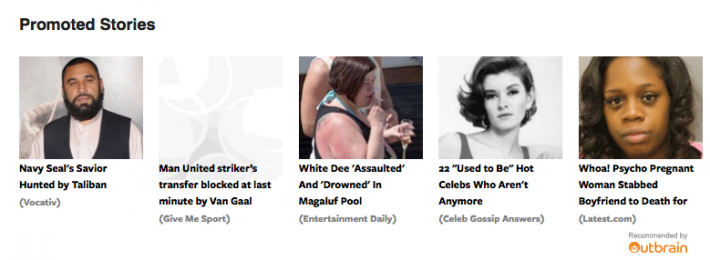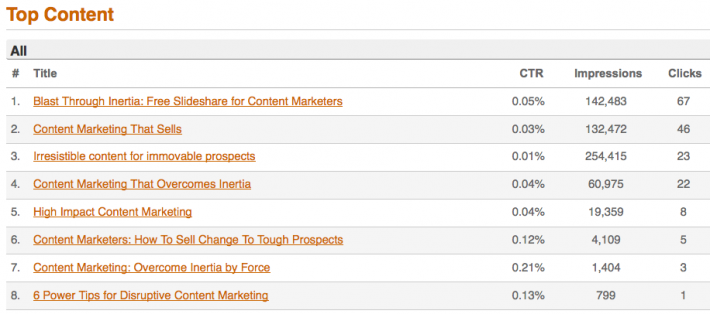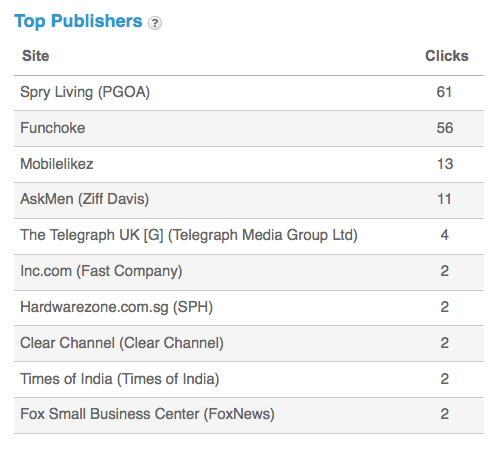As a reader, I tend to resent almost every instance of native advertising.(See Native Advertising’s Apologists Miss The Point).
For publishers I fear it’s a Faustian pact: sell your hard-earned reader trust for short-term revenue (or possibly, I admit, for survival).
But for marketers, I say ‘Go for it.’ There are audiences out there hungry for your content. Your job is to find them.
So we thought we’d run a quick test of one of the leading native advertising platforms, Outbrain. This is their elevator pitch:
“Grow your audience by distributing your content on other sites, where people are looking for something new to discover. The audience coming from Outbrain is already in content consumption mode, therefore more engaged and more likely to stay longer.”
Outbrain is essentially like the Google ad network but for content ads. You’ve seen their ads (or those of similar services like Taboola) at the bottom of posts and articles all over the web. they look like this:
The ads are all for content, not products and they’re rarely if ever relevant to the article they appear under. The ads above appeared under a blog post about content marketing on Outbrain’s own site. Maybe the connection between ‘used to be hot celebrities’, ‘psycho pregnant’ women and content marketing is too subtle for my primitive human algorithm (which triggered a ‘Say what?’ alert).
Pando Daily removed a similar service, from Gravity, on the grounds of embarrassing irrelevance as Paul Carr explained in this post.
As a publisher, like Pando, seeing dramatically off-brand content should be mortifying. As a brand, I also wonder whether the ads my stuff would appear next to would be for things like sure-fire Abs pills or free Prada handbags. The context we tend to think about is whether the site and article are right for our ads. But you do have to think about your ad neighbours, too.
Anyhoo, we thought we’d give it a go.
Whoah — this is easy.
First thing we learned: Outbrain has made it incredibly easy to start and manage a campaign. Taking a page from the Google Adwords book (okay, stealing the whole book), they’ve created a super-simple self-service campaign creator and manager:
You log in.
Enter the URL (or RSS feed) for the content you want to promote.
Try some alternate headlines and images to test for the best performer (not easy to do but possible).
Tell it the Cost Per Click you want to pay – I chose £0.55 because that was the default setting and I am a sheep and set a daily limit (£25 for this test.)
Choose your target geographies (US and UK for this test).
Then tell it how long the campaign should run (I said a week) (I know: cheapskate).
And stand back, waiting for the campaign to be ‘approved’ (not sure what would be vetoed if ‘psycho-pregnant murderers’ are fair game).
We decided to test Outbrain by promoting a brand new Slideshare: Irresistible Content for Immovable Prospects. So the image statyed the same – the cover of the piece – and we just tested ten headlines.
Tracking Codes
‘Performance’ for Outbrain is clicks (where they make their money). But for me, it’s all about conversions: things like how many people actually read the whole piece, spend time on our site, go and get other pieces and, ultimately, sign up for our newsletter or — God forbid – become a client.
Fortunately, Outbrain lets self-service customers add a tracking code to the campaign URL so you can identify Outbrain-generated traffic in your analytics and see what those clicks are really worth. If you spend enough every month, they’ll do some conversion tracking for you.
For this pilot, I’ve ignored tracking codes and conversions just to focus on the topline: how the tool works and how well it drives views. But real conversions, of course, are the only way to measure real ROI for any campaign.
(For what it’s worth, my hypothesis would be that Outbrain-generated traffic would under-perform other sources on engagement metrics, for reasons that will become apparent).
Whoah — this is maybe too easy.
Unlike Google Ad Words or LinkedIn ads or Twitter promoted tweets, you don’t really get to preview your ads. You submit them for approval and wait. I’m not crazy about this but at least you can try different versions (they don’t seem to encourage it as it’s far from intuitive to do).
A day after setting up the campaign, we got an email saying “Congratulations! Your campaign has been approved.”
And ‘approved’ means – “It’s live.”
Which means, “Don’t trouble your tiny little brain about what your ads look like or even WHERE THEY APPEAR — we’ll take care of all that. We know best.”
And that’s the problem I have with Outbrain.
The Black Box
Outbrain is ‘black box’ content distribution. Stick in a piece of content and stand back.
Not being able to preview my ads is annoying but the opacity of the sites they’ll be appearing on is far more worrying.
Outbrain tells you very, very little about their publisher network. They tell you nothing about the size and reach of the network, what publishers they’re working with or the demographics they’re able to reach.
I believe this is because the network is fairly limited and the more specialised your content is, the less likely it is that you’ll find enough relevant publishers in their network.
In other words, our ads won’t appear on sites that I’d consider relevant.
Does relevance matter?
Call me old-fashioned but I kind of buy in to the idea that an ad about, say, content marketing, should appear in places where content marketers congregate because it’s where content marketing is discussed.
Here’s what Outbrain says about that.
Yikes. That’s a big argument hiding in a throw-away marketing line. And, on principle, I just don’t buy it.I translate this statement this way:
“…the best way to deeply engage audiences” means, ‘the best way to get a click.’ But a click is NOT really engagement, though, admittedly it out-performs the lack of a click (sometimes only by a tiny margin).
“… tailor our recommendation to each and every person” means, “cookie the bastards and try not so show them stuff they’ve already seen”. This may be unfair — I don’t know because they don’t tell you what it means.
“…content that is interesting to them but not necessarily related.” means, ‘Forget that they came to this article to learn about celebrity side-boobs, they might just love a slideshare about content marketing. Let’s find out.”
I cannot imagine anyone making the claim that irrelevance is better than relevance – unless that person was selling a limited publisher network bundled up in a black box solution.
Sorry, but I don’t want my ads to be on any page with Donald Trump or any permutation of Kardashian. Their audiences are not mine. Maybe I’m still ‘brainwashed by relevance’.
But back to the test drive:
The Dashboard
The dashboard for tracking your campaigns is good. Clear and simple.
First, you see a broad overview:
And you can see it by geography or by ad unit (headline/image combination):
As you can see, my ‘Buzzfeed’ style headline out-performed all others. And, embarrasingly, the actual title of the piece was the single worst performer (maybe Barry Feldman was right: he never liked the title).
In all views, the big three metrics are as you’d expect: impressions, clicks and click-through rate. To go deeper, use the tracking code and Google Analytics.
Finally, the dashboard shows you your top ten publishers. Here were ours:
I presume they only show you the top ten publishers because 11-50 would get really embarrassing. And if this is my Top Ten, I don’t blame them.
From this list, I’d only ever MAYBE put Inc.com on a media long list. And it probably wouldn’t make the shortlist or the media plan itself.
‘Ask Men’?!
‘Spry Living’?
‘Funchoke’??? [I can only guess this is an auto-erotic self-asphyxiation community – I’m too scared to look.]
Outbrains response to this would no doubt be, “Hey — they clicked you old-school relevance-zombie’. Well, yes, they clicked. But then what?
The Hunt for Our Ad
If Outbrain wasn’t going to show us what our ad looked like or where it appeared, maybe I could use the list of my “Top Publishers” and go looking for it myself.
No luck. I tried every site listed in my Top Publishers list and I refreshed pages and scrolled infinitely (when available) looking for our lonely ad. One thing became clear: Outbrain has an enormous inventory of content it’s promoting at any one time. The chance of stumbling on our tiny ad with its miniscule spend seems to be vanishingly small.
And most of the Outbrain inventory seems to be from the Buzzfeed school of click-sluts. Which I’d hate to try to compete with.
Outbrain’s support site says, “We use a complex set of algorithms to try to find the most interesting and relevant recommendations for each individual on every page.” but it sure feels like a finger in the air.
BTW: they do let you exclude up to 5 publishers from your campaign — but you have to email them to do so.
I get that data wins over marketing instinct but, sorry, I can put together a list of 50 sites where my content ads would perform FAR better than Men’s Health. But if these sites aren’t on the Outbrain network, they can’t reach them.
Conclusion
On the main metrics, Outbrain delivered. They said I’d pay £0.55 per click and that’s what I paid.
They couldn’t spend my entire budget in the week allotted (because I’d never out-perform the side-boob ads in their inventory) but they did what they said they’d do and it was EASY.
If you want to buy traffic, this way is worth considering. But if you want to build an audience in a fairly specific niche, I’m not yet convinced.
Content marketing is a specialised discipline. I haven’t done the test to see what Outbrain-generated traffic does once it hits our site but I will be utterly flabbergasted if a guy killing time on Funchoke is as good a prospect as someone reading a post on, say, The Content Marketing Institute or Marketing Profs or Econsultancy or Convince & Convert.
I expect the Outbrain publisher network to grow enough to let them target campaigns properly. But until then, I’d only recommend it if your offer is broad enough that it doesn’t feel silly to be on Spry, Inc.com and The Telegraph all at the same time.
For Velocity, 55p is a lot to pay for a click, so I don’t think we’ll do more Outbraining for ourselves (though we may test the conversion thing). But for the right clients, I would consider it. It’s a well-designed product and you only pay for the clicks not the impressions, so the downside is not so far down.
I’m not crazy about stooping to buy traffic alongside the purveyors of psycho-pregnant murder stories. But content marketing is no place for the squeamish.

Enjoyed this article?
Take part in the discussion












Comments
Eric Wittlake August 26th, 2014
55 pence is a rip-off! With your headlines, seriously, you should have been able to pay 20 pence, and those smarmy headlines can be well under 10. But a more, ahh, stimulating image might have been necessary. 😉
Seriously, love that you share these test results. These companies are popping up everywhere, actually the most interesting offerings on the horizon for people like you and me might be from Disqus, they have a broader network with more niche sites and because of the breadth of that network, they should be able to see who might actually be interested in content marketing, even if they then reach them someplace like Inc.
Keep the test results coming!
Doug Kessler August 26th, 2014
Thanks Eric. I’ll check out Disqus. I use them often when commenting but don’t really get their model. Will investigate.
Next experiment: sponsored tweets! (Pray for my soul).
Ryan Hines August 26th, 2014
Nice article. Thanks for sharing your experience. I was initially quite interested in Outbrain when it first started to make headlines, but now I think I’ll keep my distance.
Doug Kessler August 27th, 2014
Hi Ryan. I do think it’s worth keeping an eye on Outbrain and similar platforms.
As the publisher networks get better, the targeting must get more granular.
At least that’s what I’m hoping.
Maybe this is like a typical ad network (remnant inventory) play and the price of cheap impressions is sacrificing relevance. That’s fine for some brands but not all.
Doug Kessler August 27th, 2014
Ildar — good point about native. I don’t think they call themselves that but I bundle them in because they do ads that look like editorial (even if not highly nativised for each site).
Sarah Mitchell August 27th, 2014
Hi Doug,
Thanks for running this little experiment. I had it on my list of things to do but resist the projects under the Slimy Marketing Stuff subhead.
Now, about this quote from Outbrain:
“The world is brainwashed by relevancy. For years, content recommendations have been driven by relatedness. But we’ve found that the best way to deeply engage audiences is to tailor our recommendations for each and every person and instead serve up content that is interesting to them but not necessarily related.”
I’m not sure I’m brainwashed by relevancy. Isn’t relevancy is part of the human condition? I want things to be relevant. I need things to be relevant. I’m absolutely motivated by relevancy. No brainwashing needed. That little description is just an elegant way of saying we spam the heck out of all and sundry. And we do it with glee.
Marketers figured out long ago it didn’t make any sense to buy fans and followers on Facebook and Twitter. Aren’t Outbrain and other native advertising platforms essentially performing the same function but on the distribution side of content marketing?
Jonathan Tideswell August 28th, 2014
Hi Doug,
Thanks for posting the results of your test.
In my opinion, Outbrain and Taboola are not true native advertising. Native would indicate to me that the advert is in a format that delivers a user experience that is near identical to that which would be delivered by a site when there is no commercial intent.
The above ad platforms deliver nothing more than display which directs to a piece of content rather than say, a form for lead generation or an order page on an e-commerce platform. The difference is the display is strapped to the bottom of a piece of content as supposed to being above or adjacent to it.
When a platform is focused on delivering clicks and not user value the, “blindness” which has been the blight of banner advertising I believe will occur.
I work for a regional news publisher and when I run a native campaign for my clients it is done in a style that is editorially and visually aligned to our platform and user experience. This to me is true native advertising.
John Bottom August 28th, 2014
Excellent stuff Doug – and thanks for sharing your experience. Apart from being fundamentally wrong, their attitude to ‘relevancy’ seems to conceal a sense of anger: “The world is brainwashed by relevancy”. These people are scarred. Perhaps the books they read as children were somehow too, well, suitable. But then if they talk to someone who doesn’t really believe in relevancy themselves, they will be able to sell the idea of pure clicks as a measurement. If they’re all happy in that place, that’s fine. But not for me…
Doug Kessler August 28th, 2014
Sarah: Yeah, I don’t buy the anti-relevancy argument either. But a lot of Outbrain’s clients are publishers pushing stories to get people to their sites — so the side-boob approach may be fine for them.
Jonathan: Good points. I guess there is a spectrum of native advertising but I’d put Outbrain on it. In some deployments I’ve seen the content ads are really mixed in with the editorial — they’re not always on a bar at the bottom.
Check out http://www.inc.com/ and see how hard it is to tell the Outbrain ads from the Inc stories.
John: Very funny. I agree. Click-sluttery leads inevitably to lowest common denominator content.
Jeff Rutherford August 28th, 2014
Funchoke? Chuckle, chuckle.
No wonder they’re against relevancy!
Chuck Kent September 2nd, 2014
You obviously should have worked the phrase “click sluts” into one of your tested headlines – or better yet, tested a visual version – and not just buried it in this article.
Sorry, but not surprised, to find no reply from Outbrain here…